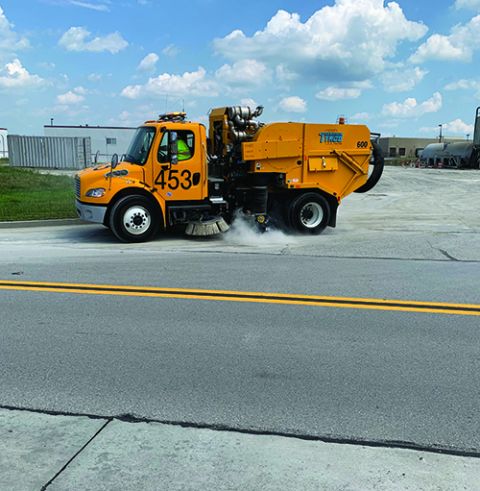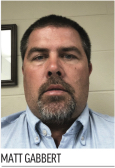Cincinnati/Northern Kentucky Int’l Uses Green Products to Address Common Airfield Challenges

Weather in the Midwest may be unpredictable, but the commitment to environmental safety at Cincinnati/Northern Kentucky International Airport (CVG) is not. The evolving Midwestern airport is proactively tackling airfield challenges with a duo of environmentally friendly products - a liquid concentrate that reduces silica exposure from pavement dust, and a deicing fluid that minimizes harmful effects to the nearby ecosystem.
Matthew Gabbert, senior manager of Airfield Maintenance at CVG, notes that he and his staff are always on the lookout for products that will make conditions and tasks safer for airport employees, passengers and neighbors.
“We want to be green in our operations and keep our eyes open to environmental concerns,” Gabbert explains. “As an organization, we take a lot of care and pride in the fact that we are doing things the right way.”
|
Project: Search for Environmental Products Location: Cincinnati/Northern Kentucky Int’l Airport Silica Dust Management Product: NeSilex, from Chemtek Key Benefit: Reduces exposure to tiny silica particles in pavement dust that are linked to lung cancer & other serious health issues Pavement Deicer: Alpine RF-14F® potassium formate-based solution, manufactured by Nachurs Alpine Solutions, using BASF formic acid Key Benefit: Provides similar performance as acetate formulas, but pulls three times less oxygen from nearby ecosystem |
Over the last three years, CVG has grown local passenger volumes by more than 50%, now serving about 9 million passengers per year. Air cargo is a huge part of the airport’s footprint, too. Amazon is building an air cargo hub at the airport, which represents a $1.5 billion investment; and DHL operates its second-busiest “global super hub” out of CVG. “Our airport campus has changed a lot over the last 10 years ago, so we want to make sure we’re doing our job to make sure we’re taking care of the environment around us,” Gabbert comments.
Reducing Silica Exposure
Gabbert learned about NeSilex, made by Chemtek/Aerogroup, at the International Snow Symposium in Buffalo, NY.
David Rigsbee, the company’s founder and CEO, explains that harmful silica particles in pavement dust are so small that people do not know they are floating through the air and into their lungs. But the micro-size contaminants are being linked to serious health concerns such as lung cancer, chronic obstructive pulmonary disease and silicosis.
“It’s like itty-bitty broken pieces of glass floating in the air,” says Rigsbee, noting that dangerous silica particles are released when crews cut or abrade concrete and asphalt.
To help airports address this issue, his company developed NeSilex, which is added to the water source of construction and maintenance equipment to manage the associated dust. Gabbert took two dozen quarts of the solution home with him from the Snow Symposium, and crews started using it in early May. Now, they won’t drive trucks without putting NeSilex in the water tanks first, he reports.

“When we’re sawing concrete, we use a lot of water and it creates a huge mess,” Gabbert explains. “This product actually traps the dust.”
The product has also made a tremendous difference in managing dust created by airside sweepers that run two shifts per day, he adds.
Rigsbee notes that NeSilex meets the OSHA Table 1 requirement that addresses the addition of surfactants to water, and it complies with the OSHA law that limits workers’ silica exposure to 50 parts per million over an eight-hour timeframe. For reference, that’s less than a matchbox-size individual packet of sugar spread over an entire football field.
“Silica is only dangerous if it is airborne, and it can be carried for many hundreds of yards since it is so light,” Rigsbee explains. “The only way pure water can control silica in the air is to have voluminous amounts, like a wave, knocking the dust down.”
When CVG crews add NeSilex to water in their equipment, they use much less water, Gabbert reports.
The airport found so much success with the Chemtek product, it purchased a 55-gallon barrel that it equipped with a pump to distribute the liquid. One pavement sweeper only uses about 15 ounces per day, says Gabbert.
“Dust is not good for our employees,” he emphasizes. “Several years ago, we made everybody with any exposure to it wear a face mask or respirator. We’ve seen a huge reduction in dust from the street sweeper and the 2-foot mill attached to our backhoe for repair work. It’s a lot safer.”

Greener Deicing
Gabbert decided to try a potassium formate pavement deicer from Nachurs Alpine Solutions after reading an article about its success at Denver International Airport (DEN). (Visit airportimprovement.com to read the article about DEN in our May/June 2018 issue.) Although CVG had a milder-than-usual winter in 2018/19, personnel were still able to put the environmentally friendly deicer to the test. Based on the results, Gabbert plans to continue using the product this winter. BASF has the only formic plant in the Americas, allowing for local production and supply of formic acid, the key ingredient for Alpine RF-14F®, manufactured by Nachurs Alpine Solutions.
Kerry Sayther, marketing manager for chemical intermediates at BASF, notes that RF-14F® is a 50% by weight w/w potassium formate based solution that meets FAA requirements of the latest edition SAE AMS1435D specifications.
 Sayther notes that acetate (another common deicing chemical) and formate have similar freezing points, but different environmental implications. “The chemical oxygen demand required for the potassium formate vs. acetate is three times less,” she explains.
Sayther notes that acetate (another common deicing chemical) and formate have similar freezing points, but different environmental implications. “The chemical oxygen demand required for the potassium formate vs. acetate is three times less,” she explains.
That means that potassium acetate pulls three times more oxygen that is needed by surrounding plants, wildlife and marine creatures.
Although many North American airports use potassium acetate solutions for deicing, BASF’s formic acid plant in Louisiana now makes it possible for them to access a more sustainable, biodegradable product that has been available and successfully applied in Europe for decades.
Sayther acknowledges that the somewhat higher price of potassium formate deicer is offset by performance and environmental benefits. “If environmental concerns are a focus at your airport, this is definitely the optimal choice when it comes to deicing,” she asserts.
Gabbert emphasizes that it’s important to balance cost with results. Moreover, he says that throughout his 22 years at CVG, management has always been willing to try something new. If it proves to be beneficial, then officials make sure it’s also a good investment, he adds.
Last winter, his team worked to educate crews about RF-14F® deicer, assign specific trucks to carry it and label equipment accordingly.
“The product is readily accessible, and our stormwater manager would like to trial it for a few more years yet to see how it does, since we had a mild winter,” he adds. “In addition to the environmental benefits, it should last a bit longer because it requires fewer applications.”

Everybody Benefits
“It’s so important to start paying attention to harmful airborne silica,” stresses Chemteck’s Rigsbee. “People would be surprised what we all breathe in every day.”
He says education is usually the biggest hurdle at airports; so his mission is to help them recognize dangers that may have been there all along.
When Rigsbee and Gabbert discussed the topic recently, they both reached the same conclusion: “How can you put a price on someone’s health
and life?”
 With that thought as a backdrop, Gabbert says the price of going green can be inexpensive in certain applications, and the benefits can outweigh the costs. The benefits of minimizing airborne silica from airfield pavement extend well beyond construction and maintenance workers, adds Rigsbee. “When we were doing a demo, 10 or 15 people came right through our work area—loading food for airplane carts, handling baggage and performing safety and security functions.”
With that thought as a backdrop, Gabbert says the price of going green can be inexpensive in certain applications, and the benefits can outweigh the costs. The benefits of minimizing airborne silica from airfield pavement extend well beyond construction and maintenance workers, adds Rigsbee. “When we were doing a demo, 10 or 15 people came right through our work area—loading food for airplane carts, handling baggage and performing safety and security functions.”
Gabbert agrees, noting that continued growth around CVG increases the importance of environmental awareness at the airport. As new structures are built and upgrades are made, management is committed to testing and implementing new solutions, he adds.
“We have to be mindful of our tenants and others, too, making sure they understand that we take things very seriously from both an environmental and safety standpoint,” Gabbert emphasizes. “We want to work with them to make sure we’re looking at the same goals.”
2022 Charlotte Douglas International Airport Report of Achievement
 Giving back to the community is central to what Charlotte Douglas International Airport and its operator, the City of Charlotte Aviation Department, is about, and last year was no different.
Giving back to the community is central to what Charlotte Douglas International Airport and its operator, the City of Charlotte Aviation Department, is about, and last year was no different.
Throughout 2022, while recovering from the COVID-19 pandemic, we continued our efforts to have a positive impact on the Charlotte community. Of particular note, we spent the year sharing stories of how Connections Don't Just Happen at the Terminal - from creating homeownership and employment opportunities to supporting economic growth through small-business development and offering outreach programs to help residents understand the Airport better.
This whitepaper highlights the construction projects, initiatives, programs and events that validate Charlotte Douglas as a premier airport.
Download the whitepaper: 2022 Charlotte Douglas International Airport Report of Achievement.
 facts&figures
facts&figures








